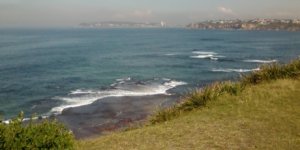New South Wales > Northern Beaches
Long Reef SE

| Type | Steep coastal hill, covered in grass, scrub and shale. |
| Conditions | South to South East |
| Height | 30m / 100' AMSL |
| Rating | PG2/3 under the supervision of an SPHGC Safety Officer or SPHGC Duty Pilot. HG Advanced |
On the South East face of Long Reef Point, 45 minutes drive from the city. Park in the car park on the northern side of Long Reef (near the golf club) then walk along the path past the lookout and around to the southern side. Please do not walk across the golf course. Alternatively you can park in the Long Reef beach car park on the southern side of the headland and walk along the Greenlink track. There are parking meters in both car parks. Free parking back at Anzac Avenue but a longer walk.
Landowners
Public land
Contact
Sydney Paragliding & Hang Gliding Club , SPHGC Safety OfficersResponsible
Sydney Paragliding & Hang Gliding ClubDescription
A curved ridge facing SSE with a steep to very steep slope. The ridge runs from the beach level on the western end, up to the crown of the headland and then turns slightly SE down to sea level at the eastern end. It is covered in a mixture of tussock grass and low bush, exposed rock and shale.
This is a good site to build up your hours with easy ridge soaring and great views down to Manly. Take care, southerly winds can be gusty with changing conditions.
Not often flown by hang gliders as it's a fair walk to carry your kit.
Takeoff
This is a cliff launch for hanglider pilots who may need wire assistance.
PG: A grassy area part way along the walking track on the southern face. The grassed area slopes backwards away from the ridge which may make launching for less experienced pilots difficult except in ideal conditions and with assistance. When the wind is straight on one option is to bring the wing up while you are a few steps down the ridge (goat track) that goes over the edge. This can be tricky and you will need a spotter to check for pedestrian traffic. When the wind is a little more south then this option may be difficult and it is recommended to lay your wing out on the northern side of the path and bring it up from there. Remember pedestrians have the right of way and be courteous. Other launch options are a sideways launch or cobra. Because the ridge rises toward the east, pilots flying eastwards tend to be lower and may need to hug the ridge. Those flying west are usually higher and often pass further out from the ridge. This is the opposite of normal right of way rules so please do not force your right of way in these circumstances.
Landing
A planned landing on the beach to the south west is the easiest option. If you get low then it is possible to bomb out on the various narrow bits of sand and tidal rock shelf in front of the take-off. However at high tide the rock shelf is covered by shallow water. You will be able to stand but the wave action means you could lose your kit and even worse endanger yourself. Be ready to get out of your harness in these circumstances. When landing toward the western end beach there is a low spur which intersects the beach and this must be taken into account if selecting a beach landing - make sure you have the height to miss the spur. There is a sandy beach during low tide at the eastern extremity of the ridge which presents a landing option, however there is some compression around the point.
PG: Top landing is relatively easy however do not drift back too far over the golf course as the backward sloping nature around the launch means some rotor is present. You can avoid this by setting up to land in front of the path. If conditions become strong and penetration is not possible then make distance toward the southwest away from the higher ridge and land on the golf course. This is for emergency landing only.
Flight
Lower Level of controlled airspace is at 2500'.
Hazards / Comments
The two main hazards with this site are the launch (Takeoff above) and the small areas to land below the launch at high tide (see Landing above). Check the tide before launching and be prepared to wait until you are sure conditions will support above the ridge soaring.
In moderate conditions, launching from the top is difficult. An alternative is launching from the goat track, however good ground handling skills are essential. On launching, the steep slope means that your wing may overshoot. You need to be prepared to check it early. The normal approach is to kite the wing (often from a bundled launch) and walk, assisted by the wing, back up the slope (in the goat track) onto level ground before turning and launching. However in stronger conditions be prepared to launch from the goat track and even launch before you have turned.
When the wind is from the west of south, conditions become more gusty and the lift becomes uneven, it is strongly recommended that pilots do not fly this site in these conditions.
PG2/3 Conditions
PG2/3 pilots must have supervision from a club SO who will assess the conditions ie tide, wind direction/strength.